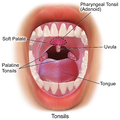Tonsil
| Tonsil | |
|---|---|
 | |
 Sagittal view of tonsils and throat anatomy | |
| Details | |
| System | Immune system,lymphatic system |
| Identifiers | |
| Latin | tonsilla, tonsillae (pl.) |
| TA98 | A05.2.01.011 |
| FMA | 9609 |
| Anatomical terminology | |
Thetonsilsare a set oflymphoidorgans facing into the aerodigestive tract, which is known asWaldeyer's tonsillar ringand consists of theadenoid tonsil(or pharyngeal tonsil), twotubal tonsils,twopalatine tonsils,and thelingual tonsils.These organs play an important role in the immune system.
When used unqualified, the term most commonly refers specifically to the palatine tonsils, which are two lymphoid organs situated at either side of the back of the human throat. The palatine tonsils and the adenoid tonsil are organs consisting of lymphoepithelial tissue located near theoropharynxandnasopharynx(parts of thethroat).
Structure
[edit]Humans are born with four types of tonsils: the pharyngeal tonsil, two tubal tonsils, two palatine tonsils and the lingual tonsils.[1]
| Type | Epithelium | Capsule | Crypts | Location |
|---|---|---|---|---|
| Pharyngeal tonsil(also termed "adenoid" ) | Ciliated pseudostratified columnar(respiratory epithelium) | Incompletely encapsulated | Small folds—sometimes described as crypts[2] | Roof ofpharynx |
| Tubal tonsils | Ciliated pseudostratified columnar (respiratory epithelium) | Roof of pharynx | ||
| Palatine tonsils | Non-keratinized stratified squamous | Incompletely encapsulated | Long, branched[3] | Sides oforopharynxbetween palatoglossal and palatopharyngeal arches |
| Lingual tonsils | Non-keratinized stratified squamous | Incompletely encapsulated | Long, unbranched[3][4] | Behindterminal sulcus (tongue) |
Development
[edit]The palatine tonsils tend to reach their largest size inpuberty,and they gradually undergoatrophythereafter. However, they are largest relative to the diameter of the throat in young children. In adults, each palatine tonsil normally measures up to 2.5 cm in length, 2.0 cm in width and 1.2 cm in thickness.[5]
The adenoid grows until the age of 5, starts to shrink at the age of 7 and becomes small in adulthood.[medical citation needed]
Function
[edit]The tonsils are immunocompetent organs that serve as the immune system's first line of defense against ingested or inhaled foreign pathogens, and as such frequently engorge with blood to assist in immune responses to common illnesses such as the common cold. The tonsils have on their surface specialized antigen capture cells calledmicrofold cells(M cells) that allow for the uptake of antigens produced by pathogens. These M cells then alert the B cells and T cells in the tonsil that a pathogen is present and an immune response is stimulated.[6]B cells are activated and proliferate in areas called germinal centers in the tonsil. These germinal centers are places where B memory cells are created andsecretory antibody (IgA)is produced.
Clinical significance
[edit]
The palatine tonsils can become enlarged (adenotonsillarhyperplasia) or inflamed (tonsillitis). The most common way to treat tonsillitis is withanti-inflammatory drugssuch asibuprofen,or if bacterial in origin,antibiotics,e.g.amoxicillinandazithromycin.Surgical removal (tonsillectomy) may be advised if the tonsilsobstruct the airwayor interfere with swallowing, or in patients with severe or recurrenttonsillitis.[7]However, different mechanisms of pathogenesis for these two subtypes of tonsillar hypertrophy have been described,[8]and may have different responses to identical therapeutic efforts. In older patients, asymmetric tonsils (also known as asymmetric tonsil hypertrophy) may be an indicator ofvirally infectedtonsils, or tumors such aslymphomaorsquamous cell carcinoma.
Atonsillolith(also known as a "tonsil stone" ) is material that accumulates on the palatine tonsil. This can reach the size of ablueberryand is white or cream in color. The main substance is mostlycalcium,but it has a strong unpleasant odor because ofhydrogen sulfideandmethyl mercaptanand other chemicals.[9]
Palatine tonsil enlargement can affect speech, making ithypernasaland giving it the sound ofvelopharyngeal incompetence(when space in the mouth is not fully separated from the nose's air space).[10]Tonsil size may have a more significant impact on upper airway obstruction for obese children than for those of average weight.[11]
As mucosal lymphatic tissue of the aerodigestive tract, the palatine tonsils are viewed in some classifications as belonging to both thegut-associated lymphoid tissue(GALT) and themucosa-associated lymphoid tissue(MALT). Other viewpoints treat them (and thespleenand thymus) as large lymphatic organs contradistinguished from the smaller tissue loci of GALT and MALT.
Additional images
[edit]-
Illustration of frontal view of tonsils
References
[edit]- ^"Definitive pharynx; Thyroid; Middle ear; Tonsils; Thymus".embryology.ch.Archived fromthe originalon 22 November 2010.Retrieved2018-10-15.
- ^Fagö-Olsen H, Dines LM, Sørensen CH, Jensen A (12 February 2019)."The Adenoids but Not the Palatine Tonsils Serve as a Reservoir for Bacteria Associated with Secretory Otitis Media in Small Children".mSystems.4(1).doi:10.1128/mSystems.00169-18.PMC6372837.PMID30801022.
- ^ab"The Lymphatic System".act.downstate.edu.Archived fromthe originalon 2017-02-02.Retrieved2017-01-29.
- ^Shahid S."Tonsils".Ken Hub.Retrieved2023-01-17.
- ^Michaels L (1987)."Normal Anatomy, Histology; Inflammatory Diseases".Ear, Nose and Throat Histopathology.Springer London. pp. 265–272.doi:10.1007/978-1-4471-3332-2_26.ISBN9781447133322.
- ^Kato A, Hulse KE, Tan BK, Schleimer RP (April 2013)."B-lymphocyte lineage cells and the respiratory system".The Journal of Allergy and Clinical Immunology.131(4): 933–57, quiz 958.doi:10.1016/j.jaci.2013.02.023.PMC3628816.PMID23540615.
- ^"Tonsils | Tonsilitis | Lymph Nodes".MedlinePlus.U.S. National Library of Medicine.Retrieved2017-01-29.
- ^Ezzeddini R, Darabi M, Ghasemi B, Jabbari Moghaddam Y, Abdollahi S, Rashtchizadeh N, et al. (April 2012). "Circulating phospholipase-A2 activity in obstructive sleep apnea and recurrent tonsillitis".International Journal of Pediatric Otorhinolaryngology.76(4): 471–474.doi:10.1016/j.ijporl.2011.12.026.PMID22297210.
- ^"Tonsil Stones Removal – What Are Tonsil Stones and How We Can Treat Them - eLimpid".elimpid.2023-05-06.Retrieved2023-05-11.
- ^Mora R, Jankowska B, Mora F, Crippa B, Dellepiane M, Salami A (September 2009). "Effects of tonsillectomy on speech and voice".Journal of Voice.23(5): 614–618.doi:10.1016/j.jvoice.2008.01.008.PMID18468843.
- ^Wang JH, Chung YS, Cho YW, Kim DY, Yi JS, Bae JS, Shim MJ (April 2010). "Palatine tonsil size in obese, overweight, and normal-weight children with sleep-disordered breathing".Otolaryngology–Head and Neck Surgery.142(4): 516–519.doi:10.1016/j.otohns.2010.01.013.PMID20304270.S2CID42924590.
External links
[edit] Media related toTonsilsat Wikimedia Commons
Media related toTonsilsat Wikimedia Commons

